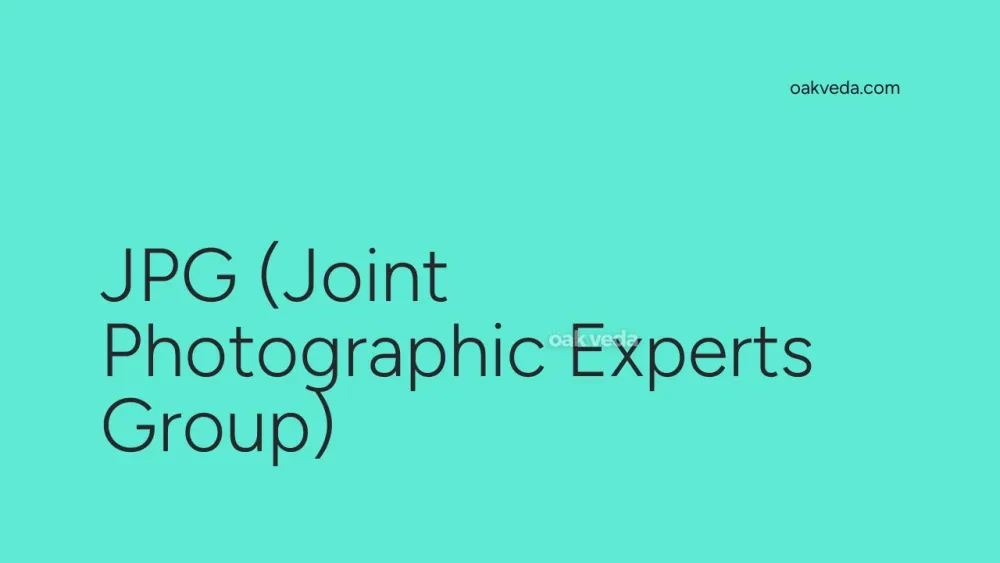
What is the Full Form of JPG?
The full form of JPG is Joint Photographic Experts Group. This term is also commonly associated with JPEG, which uses the same full form. JPG is a widely used file format for digital images, known for its efficient compression capabilities and widespread compatibility across various devices and platforms.
What is Joint Photographic Experts Group?
Joint Photographic Experts Group refers to both the committee that created the JPG standard and the image compression technology itself. This group, formed by the collaboration between the International Organization for Standardization (ISO) and the International Electrotechnical Commission (IEC), developed the JPEG standard to address the need for efficient digital image compression.
Origin and Development of Joint Photographic Experts Group
The development of the JPEG standard began in the late 1980s when the need for efficient digital image compression became apparent. The Joint Photographic Experts Group was formed in 1986 as a joint committee (JTC 1) of ISO and IEC. Their goal was to create a standardized method for compressing photographic images while maintaining acceptable visual quality.
The first JPEG standard was published in 1992, revolutionizing digital imaging and paving the way for the widespread use of digital photographs in various applications, from personal computers to the World Wide Web.
How does Joint Photographic Experts Group work?
The JPEG compression algorithm works by analyzing an image and discarding information that is less perceptible to the human eye. This process, known as lossy compression, allows for significant file size reduction while maintaining visual quality that appears satisfactory to most viewers.
The compression process involves several steps:
- Color space transformation
- Downsampling
- Block splitting
- Discrete Cosine Transform (DCT)
- Quantization
- Entropy coding
These steps work together to reduce the file size while preserving the most important visual information.
Functions of Joint Photographic Experts Group
The primary functions of the JPEG format include:
- Image Compression: Reducing file sizes for efficient storage and transmission
- Maintaining Visual Quality: Balancing compression with acceptable image quality
- Interoperability: Ensuring compatibility across various devices and software
- Flexibility: Allowing adjustable compression levels to suit different needs
Applications of Joint Photographic Experts Group
JPG files are used in numerous applications, including:
- Digital photography
- Web graphics
- Social media sharing
- Print media
- Document storage
- E-commerce product images
- Digital art and design
Features of Joint Photographic Experts Group
Key features of the JPG format include:
- Lossy Compression: Allows for significant file size reduction
- Adjustable Compression Levels: Users can balance file size and image quality
- Wide Color Range: Supports up to 16 million colors
- Progressive Loading: Enables images to load gradually, improving user experience on slower connections
- Metadata Support: Allows for embedding of information like camera settings and copyright details
Benefits of Joint Photographic Experts Group
The JPG format offers several advantages:
- Small File Sizes: Enables efficient storage and quick transmission of images
- Universal Compatibility: Supported by almost all image-viewing software and hardware devices
- Flexible Quality Settings: Allows users to choose between smaller file sizes and higher image quality
- Efficient Web Performance: Helps websites load faster due to smaller image sizes
- Reduced Storage Costs: Smaller file sizes lead to lower storage requirements and costs
Limitations or Challenges of Joint Photographic Experts Group
Despite its popularity, JPG has some limitations:
- Loss of Quality: Repeated saving can lead to noticeable degradation of image quality
- No Transparency Support: Unlike formats like PNG, JPG doesn't support transparent backgrounds
- Not Ideal for Text or Graphics: Can produce artifacts around sharp edges, making it less suitable for text or graphic images
- Limited to 8-bit Color Depth: May not be suitable for professional photography or printing applications requiring higher color depth
Future Developments in Joint Photographic Experts Group Technology
While JPG remains widely used, newer formats are emerging to address its limitations:
- JPEG 2000: Offers improved compression and support for lossless compression
- JPEG XR: Provides better compression and supports higher dynamic range
- HEIF (High Efficiency Image Format): Offers improved compression efficiency over traditional JPG
These formats aim to provide better image quality at smaller file sizes, though JPG's widespread support ensures its continued relevance.
FAQs on JPG Full Form
-
What file extensions are used for JPG images? Common extensions include .jpg, .jpeg, .jpe, .jfif, and .jif.
-
Is JPG lossy or lossless compression? JPG uses lossy compression, meaning some data is lost during the compression process.
-
Can JPG files support animation? No, standard JPG files do not support animation. For animated images, formats like GIF or APNG are used.
-
How does JPG compression affect image quality? Higher compression rates result in smaller file sizes but can lead to visible artifacts and loss of detail.
-
Is JPG suitable for storing important documents? While JPG can be used for document scans, formats like PDF are generally preferred for important documents due to better text quality and searchability.
In conclusion, the Joint Photographic Experts Group format, commonly known as JPG, has played a crucial role in the digital imaging landscape. Its efficient compression capabilities and widespread support have made it a cornerstone of digital photography and web graphics. While newer formats continue to emerge, JPG's balance of quality, file size, and compatibility ensures its ongoing relevance in the digital world.
You may be interested in:

